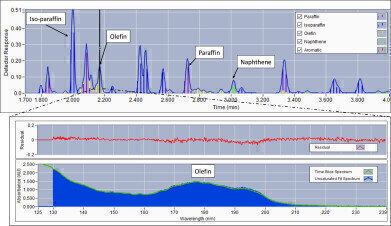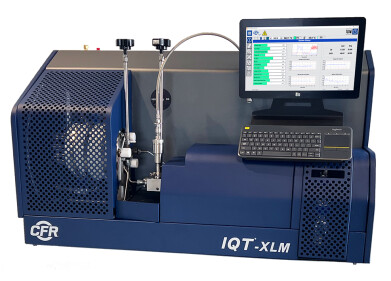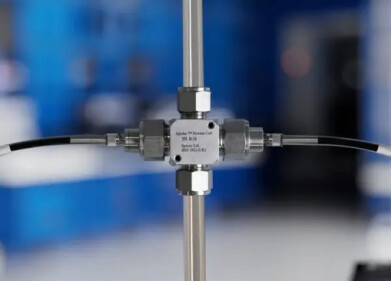-
 Figure 1: Zoomed-in chromatogram of gasoline sample with key PIONA compound class representative peaks labeled. Inset figure shows olefin spectral and residual fit data.
Figure 1: Zoomed-in chromatogram of gasoline sample with key PIONA compound class representative peaks labeled. Inset figure shows olefin spectral and residual fit data.
Analytical Instrumentation
ASTM International Approves Method D8071 for Finished Gasoline Analysis
Mar 03 2017
VUV Analytics Inc. is pleased to announce the approval of its first ASTM International method, D8071 for the analysis of finished gasoline. The D02 committee meeting approved it as “Standard Test Method for the Determination of Hydrocarbon Group Types and Select Hydrocarbon and Oxygenate Compounds in Automotive Spark-Ignition Engine Fuel using Gas Chromatography with Vacuum Ultraviolet Absorption Spectroscopy Detection (GC-VUV).” The method provides complete PIONA compound class characterisation in a single measurement, potentially replacing the use of multiple legacy methods for this analysis. VUV Analytics promotes the method as having relatively simple instrumentation combined with automated analysis software that results in shorter run times and a more robust production solution than ASTM methods D6730 and D6839, and having the potential to replace the use of multiple ASTM methods (e.g. D5769, D5580, D1319, D6550, D3606, D4815, D5599, D5845) for measurement of finished gasoline.
Measurement of bulk composition of hydrocarbon groups and individual compounds in gasoline is important for quality control as well as ensuring compliance with various governmental regulations. As such, multiple ASTM methods exist for measuring various aspects of gasoline samples. VUV Analytics asserts that most of the legacy methods are limited in scope to a subset of hydrocarbon groups or specific compounds of interest, meaning that multiple methods are required for typical production control. More comprehensive methods such as ASTM D6730 and ASTM D6839 tend to involve complicated instrumentation and/or setup procedures. These methods have no inherent ability for self-monitoring of measurement results (e.g., a fit criteria or similar), and instead rely on precise definition and control of retention times, resulting in more error-prone production measurements.
VUV Analytics guarantees that the commercial application VUV PIONA+™ for gasoline measurement is fully compliant with Method D8071. VUV PIONA+™ is enabled by the VGA-100 vacuum ultraviolet (VUV) absorption GC detector and an analysis engine called VUV Analyze. GC-VUV absorbance data is inherently three dimensional and specific to compound chemical structure, allowing some of the separation to occur at the detector. This means that standard analyses that previously required complex chromatographic separation can be simplified and shortened due to the ability to deconvolve overlapping spectral responses. VUV absorbance spectra are typically highly structured and distinct for individual compounds, yet exhibit the intuitive property of having similar features when measuring related compound classes.
The VUV Analyze engine implements equations and fit procedures that result in deconvolution of absorbance spectra that contain contributions from multiple species, is capable of binning and storing response contributions from each deconvolution analysis, and reporting a combined total response at the end of the analysis. The data processing includes a database
library of VUV reference spectra, compound class information, density, approximate retention index values, relative response factors for each hydrocarbon class, and relative response factors for individually reported compounds.The compound class or specific compound concentrations can be reported as mass or volume percent.
The VUV PIONA+™ method uses straightforward instrumentation: a gas chromatograph, a standard 30m nonpolar column, and a VGA detector. Bulk concentrations of the hydrocarbon classes of paraffins, isoparaffins, olefins, naphthenes, and aromatics (PIONA) are determined. Specific analytes can also be singled out for further characterization. The setup procedure is easy and requires no pre-column tuning or valve timing adjustments. Additionally, faster runtimes can be achieved given the method’s ability to handle co-elution among various species and hydrocarbon classes.
Figure 1 shows a zoomed-in retention time window of a sample gasoline chromatogram where PIONA compounds were separated by a 30 meter nonpolar phase capillary GC column in less than 30 minutes. Very few of the peaks displayed have achieved baseline resolution, yet all of the corresponding compound classes can be distinctly identified and quantitated. VUV Analyze software has identified each peak by its compound class (or classes) and color coded them appropriately. This PIONA analysis can be automated to provide class identification and quantitation of chromatogram peaks within seconds. Figure 1 inset shows the VUV absorbance spectrum and fit of an olefin compound between 2.0 and 2.2 minutes.VUV Verified technology enables the analyte absorbance data to be rapidly compared to the known spectral profiles of PIONA compounds. The analyte is identified as being an olefin compound and verified by the overlapping fit spectrum. The zero value residual fit data further validates the olefin compound class identity. This VUV PIONA+™ methodology eliminates the compound/class identification error inherent to alternative detection technologies.
Digital Edition
PIN 25.5 Oct/Nov 2024
November 2024
Analytical Instrumentation - Picturing Viscosity – How Can a Viscometer or a Rheometer Benefit You? - Sustainable Grease Formulations: Evaluating Key Performance Parameters and Testing Method...
View all digital editions
Events
Dec 03 2024 Dusseldorf, Germany
Dec 08 2024 Anaheim, CA, USA
Turkey & Black Sea Oil and Gas
Dec 11 2024 Istanbul, Turkey
Dec 19 2024 Aurangabad, India
Jan 20 2025 San Diego, CA, USA


















